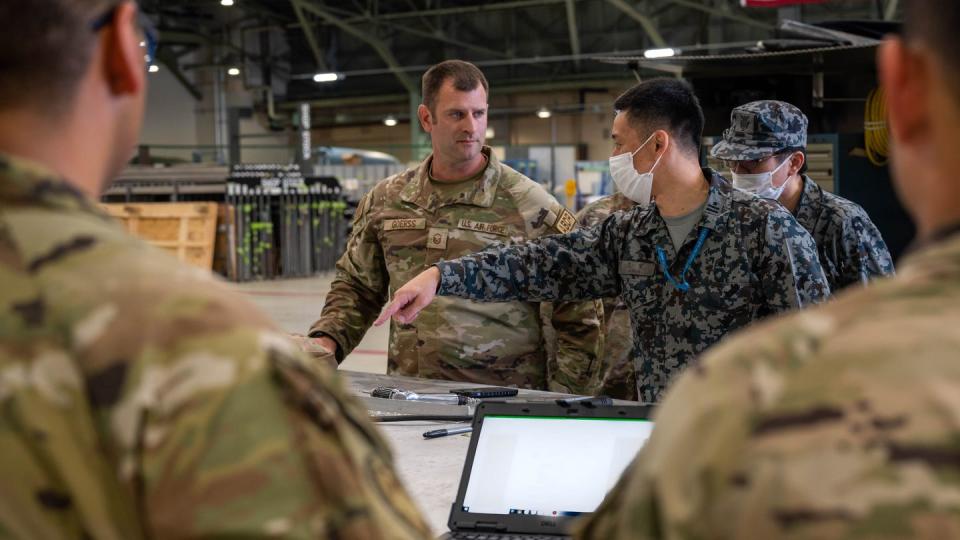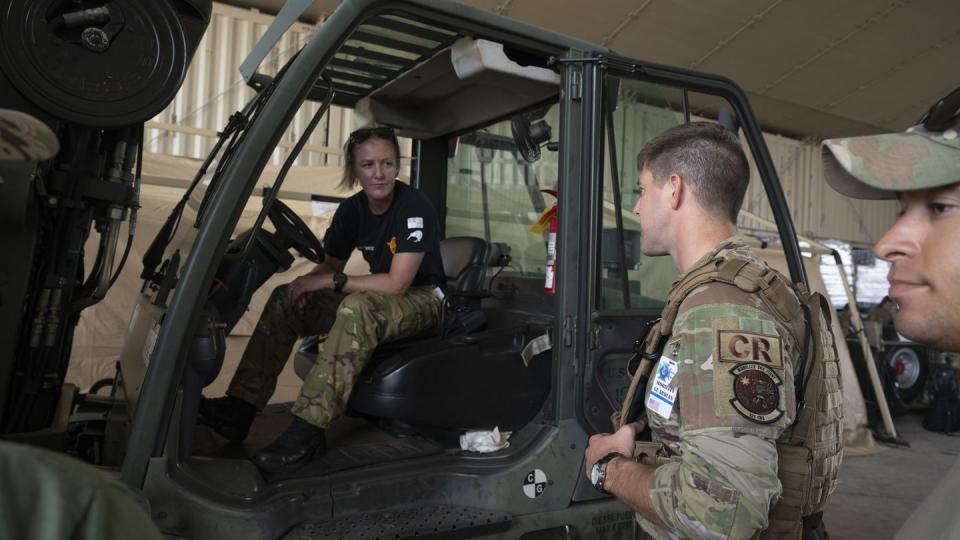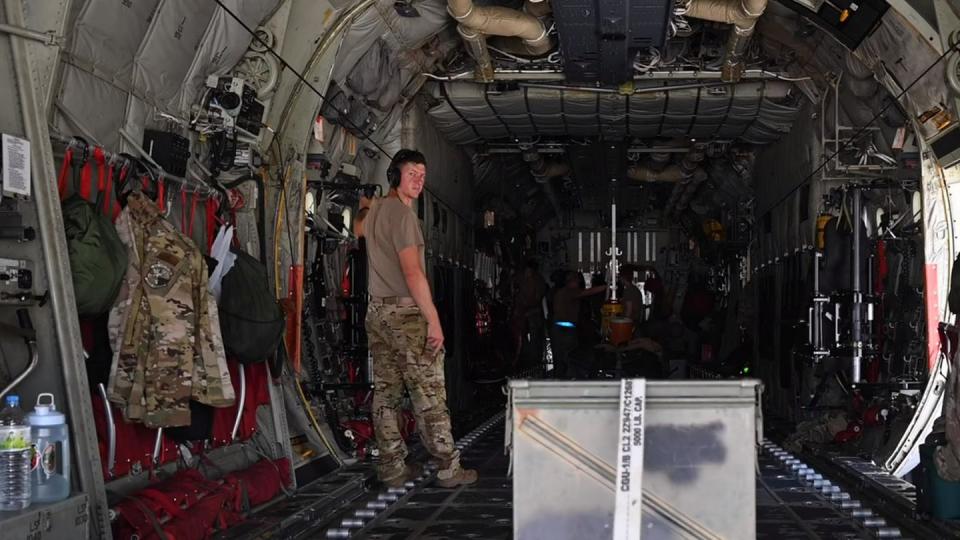For Expeditionary Center airmen, a new challenge in the Pacific
The Air Force’s pivot to the Pacific is opening a new chapter for the airmen who have long been among its first responders overseas.
Airmen under the Air Force Expeditionary Center have been on the front lines of global air operations for decades, opening and securing airfields from Afghanistan to Niger, facilitating the flow of cargo and troops around the world and liaising with foreign air units.
Last month, Mobility Guardian — the Air Force’s massive biennial training exercise for its airlift and aerial refueling units — put their skills to the test in a new arena.
Plenty went right during the two-week exercise, held at bases from Japan to Australia. But it also proved that some Expeditionary Center units aren’t as ready to operate from remote locations as they may need to be. It also sparked confusion about who should dispatch them and revealed the bureaucratic hurdles airmen must navigate as they try to enter allied countries in the Pacific, the organization’s commander said.
What’s next for air mobility, according to Gen. Mike Minihan
“We’ve got a real sense of the ‘tyranny of distance’ and how familiar we have yet to become with this theater,” Expeditionary Center Commander Maj. Gen. John Klein said.
The Expeditionary Center oversees mobility units of various sizes and skills, like self-sufficient contingency response teams that can set up and run a new airfield for up to two months, or air mobility teams that can service one aircraft for 12 hours at already-established sites.
Those airmen — a fraction of the 3,000 U.S. troops who participated in the exercise — were among the first on the ground to lay the foundation for the pilots, maintainers, loadmasters and other support staff who followed.
Orchestrating the “fight to get to the fight” sometimes proved tricky, Klein said.
Those forces took orders from different organizations and commanders at different times, slowing their response times and causing confusion about who was supporting a particular mission.
“Having awareness of the equipment that they needed and making sure that was available to them, in the locations they were operating, was another challenge,” Klein said.
One Australia-bound team couldn’t bring its equipment along because it didn’t pass an agricultural inspection to enter the country, he said.

That meant a contingency response team couldn’t properly hand off operations of their site in Australia to the longer-term air expeditionary wing team that arrived later. The mix-up forced the airmen to talk through how they would handle that scenario instead of practicing it in real life.
In another case, a small team of airmen headed to the Philippines with a limited mission: handle flightline operations, like loading and unloading cargo, for one aircraft at a time over just 12 hours.
But others mistakenly thought the group was there to service lots of other aircraft, too, Klein said.
“That team … was working extended hours to try to make that mission happen,” he said. “It’s that type of communication and coordination [problems] between the 613th [Air Operations Center] and 618th AOC that created some of those issues.”
The exercise also offered insight into how the Expeditionary Center’s new air mobility teams should mature.
The teams, comprised of airmen who are used to working at established bases, will need a more robust set of tools and logistical support if island-hopping is to be feasible, Klein said.
Tasking those units may also become easier if the teams have command-and-control specialists to act as liaisons with the AOCs, and if airmen had more communications equipment and training to avoid confusion, he added.
“Decisions over the past several years have led the Air Force to pull the command-and-control function out of the air mobility squadron,” he said. “I think we need to work to put that back in.”
He’d also like to include vehicle mechanics in those units to avoid major delays if something breaks in the field.
Standardizing those teams and giving them more time in the field to practice will build the muscle memory they need to succeed in a real crisis, Klein said.
Other situations tested how well even more established teams could think on the fly.
Unexpected jet maintenance forced a contingency response team to figure out how to accomplish the mission with fewer people than they would normally have.
Usually, it takes 100 contingency response airmen to open and run an airfield, Col. Daniel Mollis, commander of the 621st Contingency Response Group at Joint Base McGuire-Dix-Lakehurst, New Jersey, told Air Force Times in Guam.

Mollis’s team arrived at Andersen Air Force Base, Guam, on July 3 with only 25 airmen and one-quarter of their equipment while they waited for mechanics to fix another jet that should have come in the same day, he told Air Force Times. Two more aircraft weren’t slated to arrive for another 24 hours.
They got to work marshaling in their own aircraft, unloading their equipment, setting up shop in tan double-wide trailers at the edge of Andersen’s flight line and preparing to welcome other planes.
Before long, the contingency response team had settled into their role at Andersen, directing inbound pilots to their parking spots and tackling hydraulic leaks from a trailer stacked with Meals, Ready to Eat.
“You’re going to use who and what you have to make [the mission] happen,” Mollis said. “We bring order to the chaos.”
Contingency response became the backstop for many other airmen around camp who arrived in Guam with fewer people and tools than expected. That illuminated another issue: Plenty of airmen have never worked with a CR team and didn’t know what they could offer.
“You’re having to learn with new people, and everybody’s getting a taste of what everyone’s doing,” Airman 1st Class Trenton McGregor, a C-17 maintenance crew chief, said in Guam. “I had to learn what [contingency response] is doing, and now I can put in perspective how my job correlates with them, so I can better help them in the future.”
Klein said Air Mobility Command can do more to ensure that Expeditionary Center forces are a “first thought, not an afterthought.”
“We’ve got some work to do … with the folks who need to know that information, whether that’s air operations centers, whether that’s [air] staffs down through the echelons, and also particular units, so they understand what our capabilities are and how they can ask for that,” he said.
Still, Mollis praised how easily foreign airmen from the six participating partner nations worked with his team, despite having never before interacted with a contingency response unit.
“The combination of how fast we could get here, and then … coalition operations syncing is, I think, a huge success,” Mollis said.
As the Air Force aims to make all airmen more expeditionary — preparing them to deploy to remote areas on short notice and succeed with limited wingmen and tools — there’s plenty they can learn from those who serve under the Expeditionary Center.
Whereas most units train at home with all the resources they need, Mollis said contingency response squadrons already practice for the austere, short-staffed operations they’ll face in real life.
Squadrons adjusting to the Air Force’s new deployment model, known as “AFFORGEN,” could spend more time around contingency response teams as part of the plan’s more robust training schedule. That’s a chance to see how those forces work and absorb some of their tactics and processes, Mollis said.

At the same time, large-scale exercises give contingency response units a sense of what they would need to quickly open several airfields at once across a region, rather than one at a time. And field training lets them experiment with new technologies like Starshield, the military version of SpaceX’s Starlink satellite internet.
The chaotic withdrawal of U.S. troops from Afghanistan in 2021 illustrated the importance of practicing operations with many moving parts, Mollis said. His team was responsible for closing down Bagram Air Base, the largest U.S. installation in Afghanistan, as the Taliban returned to power that summer.
“There were huge lessons learned on how to sequence things, and what expertise and capabilities you need at what points in time,” Mollis said. “That’s why we do these exercises for units, because the only way to really be good at deploying and redeploying is … actually moving to a location, operating and redeploying.”
“You can’t hide things when you’re actually moving across the Pacific Ocean,” he added. “You can’t make up for them and say, ‘OK, well, we’re just going to simulate this in the exercise.’ ”
Klein pointed to the withdrawal as an example of why the Expeditionary Center needs to address its command-and-control hiccups. Airmen made the mission happen, he said, but it was more difficult than it should have been.
“I think we’re at a point where if we don’t fix some of those things, we’re just going to cripple our airmen,” Klein said.

